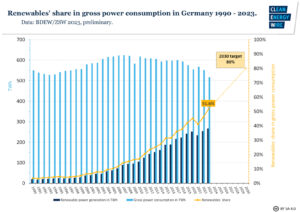The energy efficiency, cost savings, and versatility of heat pump water heaters (HPWHs) make them a clear choice for the environment and households across the U.S. With 120 million water heaters in the U.S. alone, we could save over 100 million tons in carbon emissions every year if all the water heaters in U.S. buildings were transitioned to heat pump technology. This Earth Day, join us in spreading the word about HPWHs and their many benefits. Here’s why …
HPWHs Shrink Your Carbon Footprint
Water heating accounts for 17–32% of a typical home’s energy usage, according to the U.S. Energy Information Administration. HPWHs are two to three times more efficient than gas or electric resistance water heaters, according to the U.S. Department of Energy. We ran the numbers and found that an average HPWH saves the same amount of energy as six solar panels produce annually. Plus, HPWHs use electricity, which is rapidly decarbonizing (emissions from electricity have dropped 36% since their peak in 2007).
Replacing your water heater with a HPWH today can save more than 2,000 pounds of CO2 emissions annually, according to NBI staff, and that’s the CO2 equivalent of growing more than 17 trees for 10 years, according to data from the U.S. Environmental Protection Agency (EPA). That equates to 12 tons of CO2 over the lifetime of the average water heater!
HPWHs Save More Energy & Money
HPWHs can be more expensive to purchase and install than conventional electric or gas water heaters, but the long-term cost savings are significant. Installing a HPWH can save a household of four approximately $470 per year on electricity bills compared to a standard electric water heater, according to ENERGY STAR. That’s a savings of more than $4,500 over a HPWH’s lifetime.
This year, and for the next decade, households have even more financial incentive to invest in a HPWH. The Inflation Reduction Act includes a federal tax credit of 30% of the total cost of purchasing and installing a HPWH up to $2,000. For example, if your total HPWH installation costs come to $3,000, then you’ll get a $900 tax credit. These tax credits bring HPWHs close to price parity with the upfront expense of a conventional water heater.
If you meet specific income requirements, your household could be eligible to receive an up-front rebate of up to $1,750 for HPWH installation. More details will be available when the High Efficiency Electric Home Rebate Act (HEEHRA) program rolls out later this year. In the meantime, learn more by checking out Rewiring America’s IRA calculator.
Some utilities also offer instant rebates on HPWHs. Use ENERGY STAR’s rebate finder or check with your utility to find out what models qualify.
HPWHs Improve Grid Reliability
Most HPWHs come with the EcoPort built-in smart grid connectivity, which means they can be important tools to improve grid reliability by reducing peak demand for electricity while potentially saving even more money and cutting yet more carbon. During times of high demand, such as hot summer afternoons, utilities may experience strain on the electrical grid as customers turn on air conditioning units and other appliances. This strain can lead to power outages, brownouts, or other disruptions. HPWHs can help alleviate this strain by shifting electricity use away from peak times. By heating water during off-peak hours when electricity demand is lower, HPWHs can reduce the amount of electricity needed during peak times. This can help utilities avoid strain on the grid and reduce the risk of power outages. In the future, we expect to see HPWHs use their built-in smarts to automatically help homeowners and renters maximize the use of renewable energy when it’s abundant (usually midday) and trim loads during higher-carbon times.
Important Considerations
The installation requirements for HPWHs include having adequate space for ventilation, a drain or pump to route the condensate, and a power source. HPWHs use electricity and most require a 30-amp, 240-volt circuit. This could mean having to upgrade the electrical panel for 240-volt hardwired service.
Four leading manufacturers (A.O. Smith, GE, Nyle Water Heating Systems, and Rheem) are addressing this potential barrier by releasing 120-volt HPWHs that plug into a typical 120-volt electrical outlet. Rheem is the first manufacturer to have a product on the market and the rest are expected later this year. The Advanced Water Heating Initiative (AWHI) is currently running a 120-volt HPWH field study in California. Lessons learned from the study will make retrofitting buildings with HPWHs even easier in the future, especially when replacing gas water heaters that don’t have easy access to 240 volts of power. Learn more about this exciting plug-in HPWH technology by attending a PG&E webinar on Thursday, April 27, 12:00–1:30 pm PT, Plug-In Heat Pump Water Heaters An Early Look to 120 Volt Products, where NBI senior project manager Amruta Khanolkar will present.
Heat pump water heaters are the best option for households looking to save money on energy bills and reduce their environmental impact. Be proactive and replace your water heater with a HPWH to save money while reducing your carbon footprint. This Earth Day, plant the equivalent of a forest of trees by investing in a HPWH.
Please share the images in this article widely and get the word out about heat pump water heater heaters. We have ready-made posts along with these images in this Social Press Kit.
Huge thanks to Susan Grant Harris and Becky Brun for their help writing this article. This article originally appeared on NBI’s blog.
Sign up for daily news updates from CleanTechnica on email. Or follow us on Google News!
Have a tip for CleanTechnica, want to advertise, or want to suggest a guest for our CleanTech Talk podcast? Contact us here.
Investing Thoughtfully In The EV & Cleantech Mineral Boom
I don’t like paywalls. You don’t like paywalls. Who likes paywalls? Here at CleanTechnica, we implemented a limited paywall for a while, but it always felt wrong — and it was always tough to decide what we should put behind there. In theory, your most exclusive and best content goes behind a paywall. But then fewer people read it! We just don’t like paywalls, and so we’ve decided to ditch ours. Unfortunately, the media business is still a tough, cut-throat business with tiny margins. It’s a never-ending Olympic challenge to stay above water or even perhaps — gasp — grow. So …
- SEO Powered Content & PR Distribution. Get Amplified Today.
- Platoblockchain. Web3 Metaverse Intelligence. Knowledge Amplified. Access Here.
- Minting the Future w Adryenn Ashley. Access Here.
- Source: https://cleantechnica.com/2023/04/20/this-earth-day-invest-in-a-heat-pump-water-heater-do-the-equivalent-of-planting-a-tree-or-forest/
- :is
- $3
- $UP
- 000
- 1
- 10
- 100
- 9
- a
- About
- above
- access
- According
- Accounts
- across
- Act
- addressing
- advanced
- Advertise
- agency
- AIR
- Air Conditioning
- All
- alleviate
- alone
- along
- also
- always
- amount
- an
- and
- Annually
- appeared
- appliances
- approximately
- April
- ARE
- article
- AS
- At
- attending
- automatically
- available
- average
- barrier
- BE
- behind
- benefits
- BEST
- Bills
- Bit
- bring
- built-in
- business
- by
- california
- CAN
- carbon
- carbon emissions
- carbon footprint
- challenge
- check
- checking
- chip
- choice
- cleantech
- Cleantech Talk
- clear
- Close
- co2
- co2 emissions
- come
- compared
- Connectivity
- content
- conventional
- Cost
- cost savings
- Costs
- could
- credit
- Credits
- Currently
- Customers
- cutting
- data
- day
- decade
- decide
- decided
- Demand
- Department
- details
- disruptions
- don
- Dont
- during
- e
- Early
- earth
- Earth Day
- easier
- efficiency
- efficient
- EIA
- Electric
- electricity
- eligible
- Emissions
- energy
- energy efficiency
- Environment
- environmental
- Environmental Protection Agency
- EPA
- equates
- Equivalent
- especially
- Ether (ETH)
- EV
- Even
- Every
- example
- exciting
- Exclusive
- expect
- expected
- expensive
- experience
- Federal
- field
- financial
- Find
- First
- Footprint
- For
- forest
- found
- four
- from
- future
- GAS
- ge
- get
- Goes
- grant
- Grid
- Grow
- Growing
- Guest
- Have
- having
- help
- here
- High
- Home
- HOT
- HOURS
- household
- households
- http
- HTTPS
- images
- Impact
- implemented
- important
- improve
- in
- Incentive
- include
- includes
- Income
- inflation
- information
- Initiative
- install
- installing
- instant
- into
- Invest
- investing
- IRA
- IT
- join
- Join us
- jpg
- lead
- leading
- LEARN
- learned
- Lessons
- Lessons Learned
- lifetime
- like
- Limited
- loads
- long-term
- Look
- looking
- make
- manager
- Manufacturer
- Manufacturers
- many
- margins
- Market
- max-width
- Maximize
- May..
- means
- meantime
- Media
- Meet
- million
- mineral
- models
- money
- monthly
- more
- more efficient
- most
- needed
- news
- next
- of
- offer
- Olympic
- on
- Option
- or
- originally
- Other
- our
- Outages
- over
- panel
- panels
- parity
- Patreon
- PayPal
- Peak
- People
- perhaps
- PHP
- Planting
- plato
- Plato Data Intelligence
- PlatoData
- please
- plug
- plus
- podcast
- Posts
- potential
- potentially
- pounds
- power
- present
- press
- price
- Proactive
- produce
- Product
- Program
- project
- protection
- pump
- purchase
- purchasing
- put
- qualify
- rapidly
- Read
- ready-made
- Rebate
- receive
- reduce
- reducing
- Renewable
- renewable energy
- renters
- replace
- require
- Requirements
- Resistance
- REST
- Risk
- rolls
- Route
- running
- s
- same
- Save
- saving
- Savings
- senior
- service
- Share
- SHIFTING
- should
- significant
- since
- SIX
- smart
- So
- Social
- solar
- solar panels
- Source
- Space
- specific
- Spreading
- standard
- stay
- Still
- Study
- such
- summer
- support
- Susan
- Systems
- Talk
- tax
- tax credit
- team
- Technology
- than
- thanks
- that
- The
- The Future
- their
- Them
- There.
- These
- this
- this year
- three
- times
- tip
- to
- today
- tons
- tools
- Total
- Trees
- TURN
- typical
- u.s.
- units
- Updates
- upgrade
- us
- Usage
- use
- usually
- utilities
- utility
- Ve
- via
- Volt
- was
- Water
- we
- webinar
- were
- What
- which
- while
- WHO
- widely
- will
- with
- Word
- writing
- Wrong
- year
- years
- you
- Your
- zephyrnet









